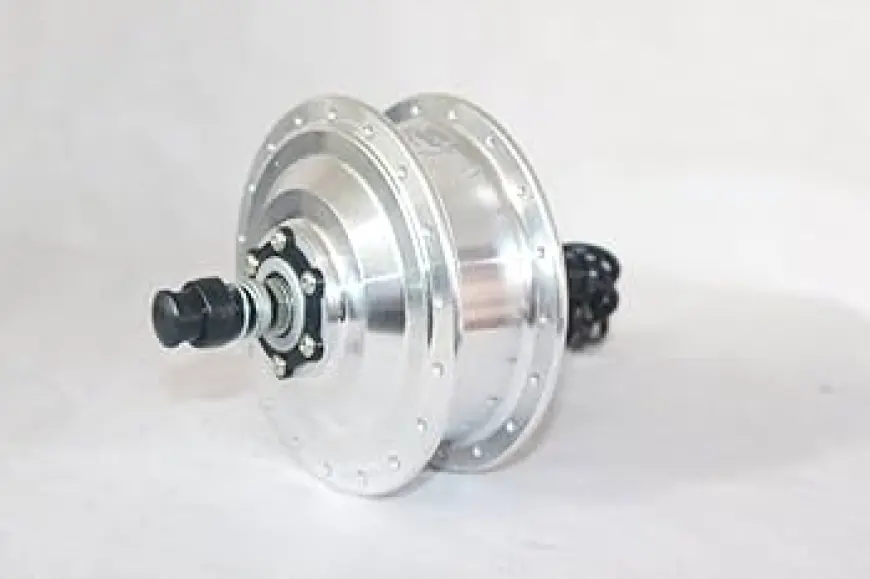Hub Motor Market Report 2025-2033, Industry Growth Opportunities, and Forecast
The global hub motor market size was valued at USD 10,173.70 Million in 2024. Looking forward, IMARC Group estimates the market to reach USD 14,720.70 Million by 2033, exhibiting a CAGR of 3.98% from 2025-2033.

According to the latest report by IMARC Group, titled “Hub Motor Market Report by Installation (Front Hub Motor, Rear Hub Motor), Vehicle Type (E-bikes, Electric Two-wheelers, Passenger Cars, and Others), Motor Type (Geared, Gearless), Power Output (Below 1000 W, 1000–3000 W, Above 3000 W), Sales Channel (OEM, Aftermarket), and Region 2025-2033,” offers a comprehensive analysis of the hub motor market forecast. The report also includes competitor and regional analysis, along with a breakdown of segments within the industry. the global hub motor market size was valued at USD 10,173.70 Million in 2024. Looking forward, IMARC Group estimates the market to reach USD 14,720.70 Million by 2033, exhibiting a CAGR of 3.98% from 2025-2033. Asia Pacific currently dominates the market, holding a hub motor market share of over 34.3% in 2024. The increasing shift towards electric vehicles (EVs), ongoing technological advancements, and continuous government efforts to promote EVs are primarily driving the market growth.
Request Free Sample Report: https://www.imarcgroup.com/hub-motor-market/requestsample
Surge in Electric Mobility and Integration of Advanced Technologies:
The hub motor market is experiencing transformative growth as the world shifts decisively toward electric mobility and sustainable transportation. One of the most significant dynamics driving this market is the escalating demand for electric vehicles (EVs), including e-bikes, e-scooters, electric motorcycles, and compact urban vehicles. Governments worldwide are rolling out ambitious electrification policies, offering robust incentives, and enforcing stringent emissions regulations to accelerate the transition away from internal combustion engines. This policy-driven momentum is compelling automotive manufacturers to invest in the integration of hub motors, which are lauded for their compact design, energy efficiency, and minimal maintenance requirements. Hub motors, mounted directly onto the vehicle wheels, eliminate the need for complex transmission systems and provide instant torque, greatly enhancing acceleration, vehicle control, and overall driving experience. The adoption of advanced battery technologies and efficient motor control systems—including permanent magnet synchronous motors (PMSM) and brushless DC (BLDC) motors—further elevates hub motor efficiency, increases range, and reduces lifecycle costs.
As urbanization intensifies and cities focus on reducing noise and emissions, the appeal of quiet, zero-emission, and low-maintenance hub motor-powered vehicles grows stronger. Major market players are respondingly investing in R&D, launching modular and customizable hub motor solutions adaptable to varying vehicle classes and user preferences, from luxury electric cars to shared micromobility fleets. As a result, the global hub motor market is on an upward trajectory, capturing significant market share across North America, Europe, and Asia Pacific, with electric mobility setting new benchmarks for performance, regulatory compliance, and sustainability.
Technological Innovations, Customization, and Market Expansion:
Rapid technological advancements and customization in hub motor design are fundamental forces shaping the market’s growth and future outlook. The latest generation of hub motors stands out for advancements in material science, improved thermal management, and sophisticated electronic control units, resulting in optimized efficiency and prolonged operational life. Innovations such as regenerative braking systems, advanced motor controllers, and battery management solutions are redefining user experience by delivering enhanced energy recovery, extended driving ranges, and improved reliability. Manufacturers are also focusing on modular and scalable solutions, enabling automotive OEMs and aftermarket players to tailor hub motor assemblies for diverse vehicle segments and specific customer requirements. This high degree of flexibility facilitates seamless integration across an expanding spectrum of EVs, from urban commuters and last-mile delivery vans to high-performance e-bikes. Major industry stakeholders are forging strategic partnerships with technology providers and battery manufacturers, accelerating the development cycle and introduction of next-generation hub motor platforms.
Regional growth focal points, such as Asia Pacific and Europe, remain at the forefront of market expansion, fueled by harnessing local manufacturing, driving down costs, and supporting localized innovation. For example, government initiatives in Asia—such as significant tax incentives in Thailand—are attracting investments and enabling the proliferation of hub motors in hybrid and electric vehicles. In Europe, the commitment to renewable energy and urban mobility solutions further amplifies hub motor adoption, especially in cities demanding compact, low-emission transport. This confluence of technological progress, increased customization, and strategic collaboration is expected to underpin the long-term expansion of the global hub motor market.
Environmental Sustainability, Regulatory Pressure, and Evolving Consumer Preferences:
Environmental consciousness and evolving regulatory frameworks stand as critical determinants of future demand in the hub motor market. Growing concerns regarding climate change, air pollution, and finite fossil fuel resources are pushing nations, industries, and individuals toward decarbonization. Hub motors, by virtue of enabling zero direct emissions and facilitating the proliferation of electric mobility solutions, have emerged as essential components in combating greenhouse gas emissions from transportation. Heightened scrutiny from national and regional regulators has resulted in more aggressive CO2 reduction targets for vehicle manufacturers, compelling industry actors to accelerate the integration of clean, electric propulsion systems. These regulatory dynamics are complemented by a significant shift in consumer attitudes: a new generation of urban dwellers and young professionals is prioritizing green, efficient, and affordable transportation, while the rise of e-commerce and last-mile delivery strengthens the case for electrified transport.
Incentives such as purchase subsidies, low-emission zones, and infrastructure support, including the expansion of EV charging networks, have further steered purchasing decisions in favor of hub motor-powered vehicles. On the manufacturing side, OEMs emphasize the use of lightweight, recyclable materials and the adoption of environmentally friendly production processes. As the market evolves, operators are seeking high-performance hub motor solutions not only for private mobility but also for commercial vehicles, delivery fleets, and public transport. This paradigm shift—reflecting both top-down regulatory mandates and bottom-up consumer demand—highlights the sustained and accelerating trajectory of hub motor adoption in the global quest for sustainable mobility.
Leading Key Players Operating in the Hub Motor Industry:
- Accell Group N.V
- Cutler MAC (Shanghai) Brushless Motor Co. Ltd
- Elaphe Propulsion Technologies Ltd
- Heinzmann GmbH & Co. KG
- Leaf Motor
- NTN Corporation
- QS Motor
- Schaeffler technologies AG & CO. KG
- Tajima Motor Corporation
- TDCM
Hub Motor Market Trends:
The hub motor market exemplifies remarkable dynamism, driven by the dual imperatives of innovation and sustainability. Electric mobility continues to reshape consumer expectations as cities worldwide seek to alleviate congestion, improve air quality, and deliver reliable, cost-effective transport options. Hub motors, with their direct drive design, lightweight build, and streamlined integration, offer a compelling combination of efficiency and simplicity—qualities highly valued in both personal and shared urban mobility solutions. Ongoing upgrades in battery technology and power electronics are enhancing range and reliability, addressing key consumer demands for performance and low maintenance.
Furthermore, the adoption of regenerative braking, modular designs, and advanced control systems is elevating product differentiation among manufacturers, allowing for tailored solutions that cater to a spectrum of vehicle platforms from urban e-scooters to high-end electric cars. Government incentives and investments in EV infrastructure are accelerating the shift from prototype innovation to mass-market adoption, making hub motors a cornerstone of the electric propulsion ecosystem. In a landscape where regulatory compliance, operational efficiency, and environmental stewardship are non-negotiable, hub motor technology is perfectly positioned to define the future of urban and micro-mobility, logistics, and clean transportation.
Ask Analyst for Instant Discount and Download Full Report with TOC & List of Figure: https://www.imarcgroup.com/hub-motor-market
Key Market Segmentation:
Breakup by Installation:
- Front Hub Motor
- Rear Hub Motor
Rear hub Motor represented the largest segment.
Breakup by Vehicle Type:
- E-bikes
- Electric Two-wheelers
- Passenger Cars
- Others
E-bikes accounted for the largest market share.
Breakup by Motor Type:
- Geared
- Gearless
Currently, geared accounts for the majority of the global market share.
Breakup by Power Output:
- Below 1000 W
- 1000–3000 W
- Above 3000 W
Below 1000 W currently exhibits a clear dominance in the market.
Breakup by Sales Channel:
- OEM
- Aftermarket
OEM holds the largest market share.
Breakup by Region:
- North America (United States, Canada)
- Europe (Germany, France, United Kingdom, Italy, Spain, Others)
- Asia Pacific (China, Japan, India, Australia, Indonesia, Korea, Others)
- Latin America (Brazil, Mexico, Others)
- Middle East and Africa (United Arab Emirates, Saudi Arabia, Qatar, Iraq, Other)
Asia-Pacific currently dominates the global market.
Key Highlights of the Report:
- Market Performance (2019-2024)
- Market Outlook (2025-2033)
- Porter’s Five Forces Analysis
- Market Drivers and Success Factors
- SWOT Analysis
- Value Chain
- Comprehensive Mapping of the Competitive Landscape
About Us:
IMARC Group is a leading market research company that offers management strategy and market research worldwide. We partner with clients in all sectors and regions to identify their highest-value opportunities, address their most critical challenges, and transform their businesses.
IMARC’s information products include major market, scientific, economic and technological developments for business leaders in pharmaceutical, industrial, and high technology organizations. Market forecasts and industry analysis for biotechnology, advanced materials, pharmaceuticals, food and beverage, travel and tourism, nanotechnology and novel processing methods are at the top of the company’s expertise.
Contact Us:
IMARC Group
134 N 4th St. Brooklyn, NY 11249, USA
Email: [email protected]
Tel No:(D) +91 120 433 0800
United States: +1-631-791-1145
What's Your Reaction?
 Like
0
Like
0
 Dislike
0
Dislike
0
 Love
0
Love
0
 Funny
0
Funny
0
 Angry
0
Angry
0
 Sad
0
Sad
0
 Wow
0
Wow
0


















































